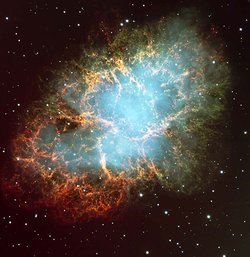Supernova remnant
|
|

Keplers_supernova.jpg

A supernova remnant (SNR) is made up of the materials left behind by the gigantic explosion of a star in a supernova. There are two possible routes to this end: either a massive star may cease to generate fusion energy in its core, and collapse inward under the force of its own gravity, or a white dwarf star may accumulate material from a companion star until it reaches a critical mass and undergoes a thermonuclear explosion. In either case, the resulting supernova explosion expels much or all of the stellar material with great force.
In the case of a massive-star explosion, the core of the star may collapse so rapidly that it forms a sort of extremely compact (degenerate) matter. This compact object, which may be a neutron star or a black hole, is referred to as a compact supernova remnant. For both massive and white-dwarf stellar progenitors, the outermost layers of the star will be blown off by the force of the explosion into an expanding cloud of dust and gas. The shock wave and ejected material expanding from this explosion, and the interstellar material it sweeps up along the way, are called a diffuse supernova remnant.
Perhaps the most famous and best-observed supernova remnant is SN 1987A, the newly formed remnant of a supernova in the Large Magellanic Cloud. A few other well-known supernova remnants are the Crab Nebula, a remnant of a relatively recent explosion (AD 1054); Tycho, a remnant named after Tycho Brahe, who recorded the brightness of its original explosion (AD 1572); and Kepler's SNR (SN 1604), named after Johannes Kepler.
Other resources
External links
- SNR Catalogue (http://www.mrao.cam.ac.uk/surveys/snrs/)(D. A. Green Cambridge University)
- NASA: Introduction to Supernova Remnants. (http://agile.gsfc.nasa.gov/docs/objects/snrs/snrstext.html)
- Supernova Remnant (http://www.site.uottawa.ca:4321/astronomy/index.html#novaremnant_table) (UOttawa)
- Afterlife of a Supernova (http://www.universetoday.com/am/publish/afterlife_supernova.html)
